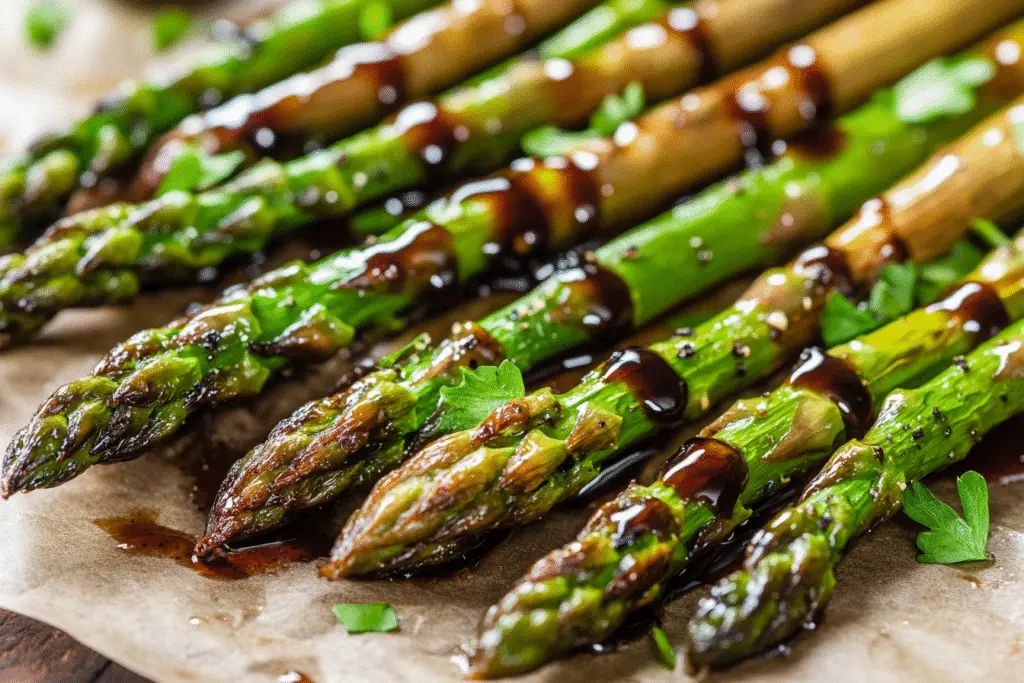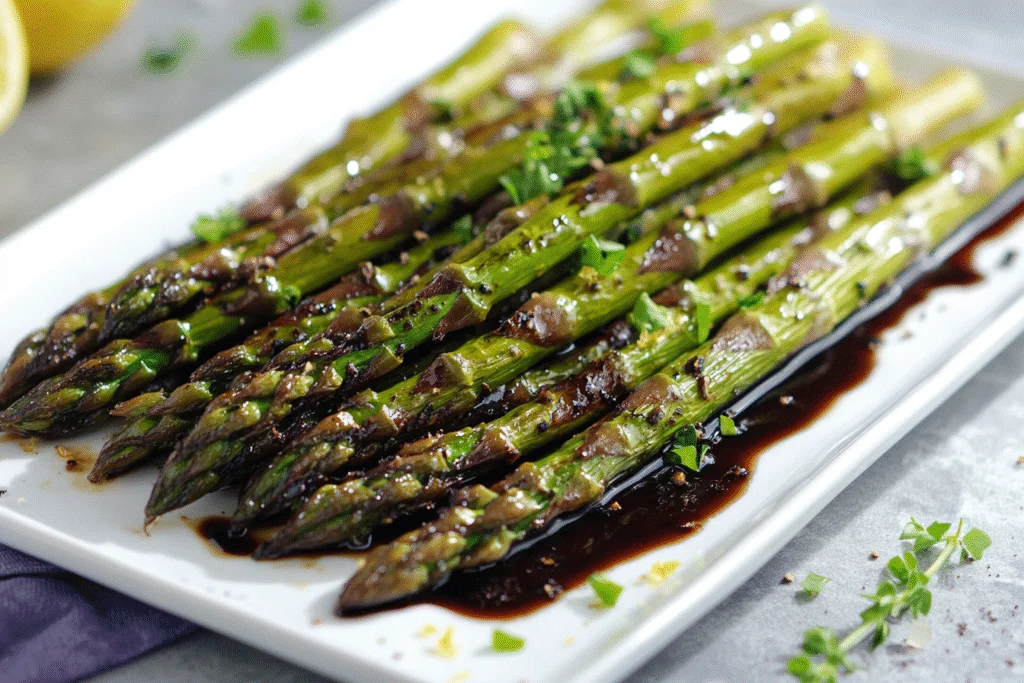When it comes to easy and elegant vegetable dishes, few can rival the charm of Balsamic Glazed Asparagus. This recipe takes tender-crisp asparagus spears and coats them in a tangy, slightly sweet balsamic reduction that intensifies their natural earthiness and transforms them into a standout side. Whether you’re cooking for a dinner party, serving up a holiday spread, or just elevating a weeknight meal, this dish is a fast, flavorful favorite that works with just about anything.
With minimal ingredients, just one pan, and under 20 minutes, this glazed asparagus is the kind of side dish you’ll find yourself making on repeat.
Why You’ll Love This Balsamic Asparagus Recipe
This isn’t just any roasted asparagus—it’s the perfect balance of bright acidity, gentle sweetness, and savory depth, all achieved with pantry staples and barely any hands-on time.
Here’s why it stands out:
- Quick to make—ready in under 20 minutes
- Uses simple ingredients but delivers bold flavor
- Works as a side dish or salad topper
- Great hot or room temperature
- Naturally gluten-free, dairy-free, and vegan
And that glossy balsamic glaze? It coats each spear with sticky-sweet tang that makes asparagus feel special—even for people who don’t usually love veggies.

Choosing the Best Asparagus
To make this dish sing, start with fresh, high-quality asparagus.
Look for:
- Firm, bright green spears
- Tightly closed tips
- Medium thickness—too thin and they may overcook, too thick and they may stay tough
If your spears are thick, consider peeling the lower half with a vegetable peeler for a more tender bite.
Balsamic Glaze: Sweet, Tangy, and Just Sticky Enough
The glaze is the star here, and it’s incredibly easy to make. You can use store-bought balsamic glaze for convenience, but homemade adds a deeper, richer flavor with just a few extra minutes.
Homemade glaze ingredients:
- Balsamic vinegar
- Maple syrup or honey (for a touch of sweetness)
- Optional pinch of salt or black pepper
Simmer the vinegar and sweetener gently until it reduces to a syrupy consistency. It thickens as it cools, so don’t overdo it—aim for a pourable glaze that lightly coats the back of a spoon.
Ingredient Variations and Additions
This asparagus is excellent on its own, but feel free to play with toppings or additions for variety.
Optional Enhancements:
- Shaved Parmesan for saltiness (skip for vegan)
- Toasted pine nuts or slivered almonds for crunch
- Lemon zest or juice for brightness
- Garlic powder or minced garlic roasted along with the asparagus
- Crushed red pepper flakes for a subtle kick
Want to make it heartier? Serve over quinoa, couscous, or a bed of greens for a light, flavorful lunch.
Ingredients
- 1 bunch (about 1 lb) fresh asparagus, ends trimmed
- 1 tablespoon olive oil
- Salt and black pepper, to taste
For the Balsamic Glaze (or use store-bought)
- ¼ cup balsamic vinegar
- 1 tablespoon maple syrup or honey
Instructions
- Preheat Oven
Preheat your oven to 425°F (220°C). Line a baking sheet with parchment paper or foil for easy cleanup. - Prepare the Asparagus
Trim the woody ends off the asparagus. Place the spears on the baking sheet, drizzle with olive oil, and season with salt and pepper. Toss to coat and spread into a single layer. - Roast
Roast for 12–15 minutes, depending on thickness, until tender and slightly browned on the tips. - Make the Balsamic Glaze (if using homemade)
While the asparagus roasts, combine balsamic vinegar and maple syrup in a small saucepan over medium heat. Simmer for 6–8 minutes, stirring occasionally, until the mixture reduces by half and coats the back of a spoon. Remove from heat and let cool slightly. - Glaze and Serve
Drizzle the warm balsamic glaze over the roasted asparagus and gently toss or serve as-is. Garnish with optional toppings if desired and serve warm or at room temperature.
Tips for Success
- Don’t overcrowd the pan—asparagus should be in a single layer to roast, not steam
- Roast just until tender—overcooked asparagus gets mushy and loses its color
- Glaze while warm—so the asparagus absorbs some of the flavor
- Use real balsamic vinegar—cheap imitations can be overly acidic or thin
Storage and Meal Prep
- Fridge: Store leftovers in an airtight container for up to 3 days
- Reheat: Warm gently in a skillet or microwave, or serve cold in salads
- Make ahead: The glaze can be made days ahead and stored in the fridge
This dish is great served warm as a side or chilled over grain bowls or salads.

Serving Suggestions
Pair your balsamic asparagus with:
- Grilled chicken, fish, or tofu
- Quinoa or farro salads
- Pasta with lemon and herbs
- Scrambled eggs or omelets for a brunch twist
- Charcuterie or cheese boards as an elegant addition
It’s light enough for a summer meal and rich enough to hold its own on a holiday table.
Nutrition Snapshot (Per serving, ~1/4 of recipe with glaze)
- Calories: ~80
- Protein: ~2g
- Carbs: ~7g
- Fat: ~5g
- Fiber: ~2g
A low-calorie, nutrient-dense side rich in antioxidants and gut-friendly fiber.
Why This Side Dish Works
- Versus steamed asparagus: More flavor and better texture
- Versus sautéed versions: Less oil and more depth from roasting
- Versus butter-based recipes: Lighter, with naturally sweet acidity
This is the kind of vegetable side that feels elevated without effort. A total weeknight win and dinner party-worthy.
Balsamic Glazed Asparagus is the definition of simple sophistication. With its tender roast, rich glaze, and just the right pop of flavor, it transforms basic vegetables into a dish that steals the spotlight. Keep it in your rotation—you’ll never look at asparagus the same way again.
